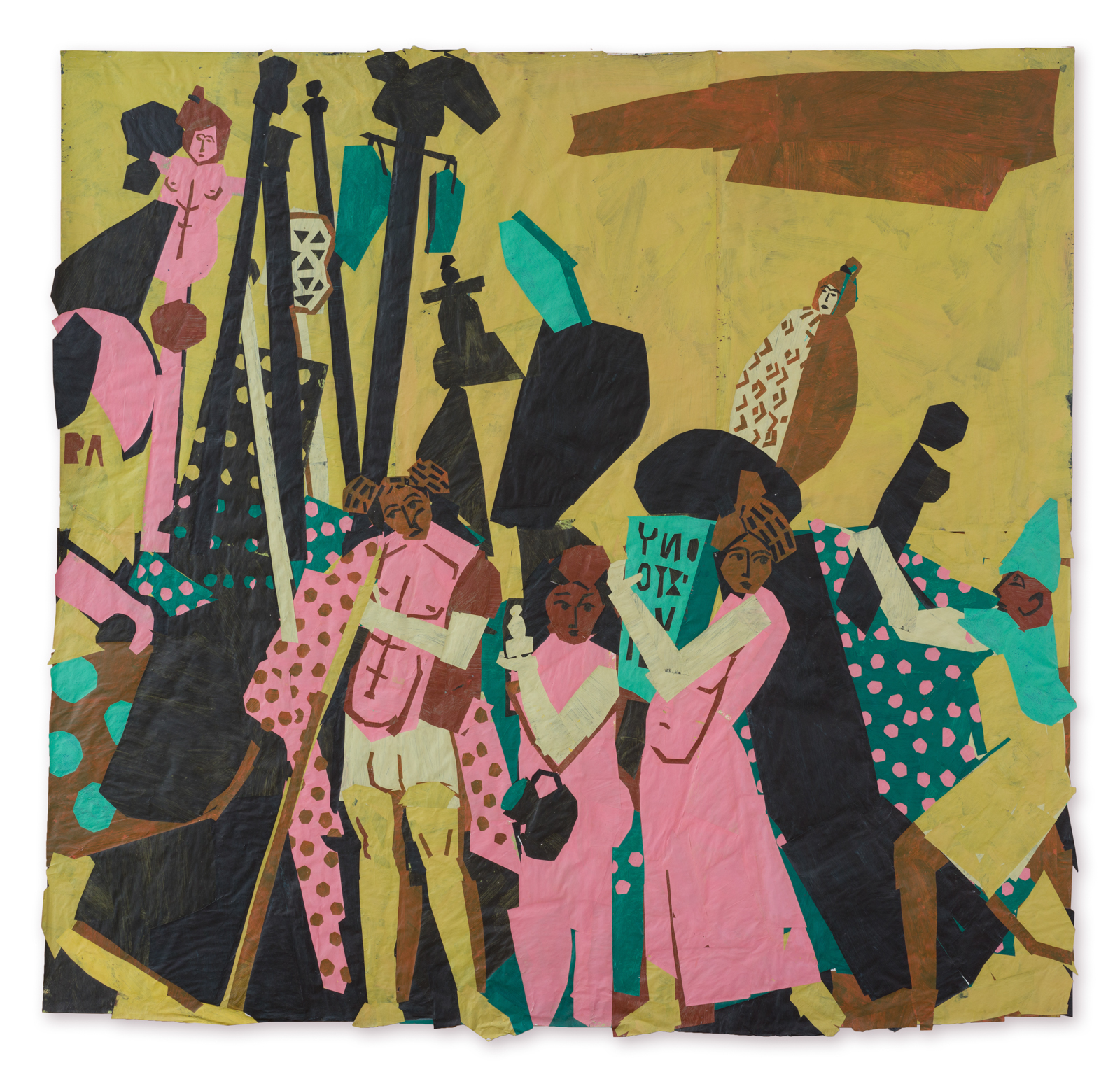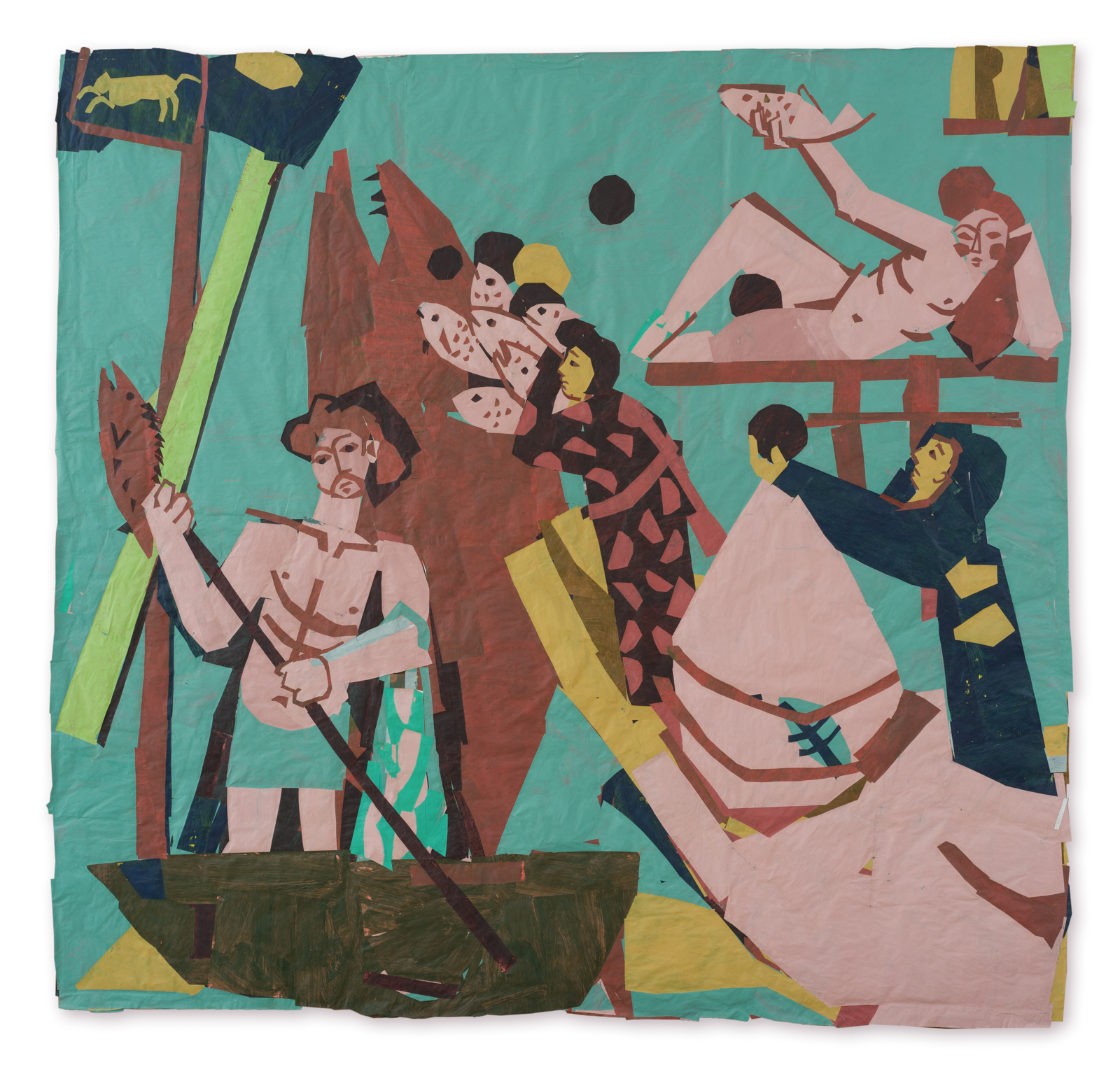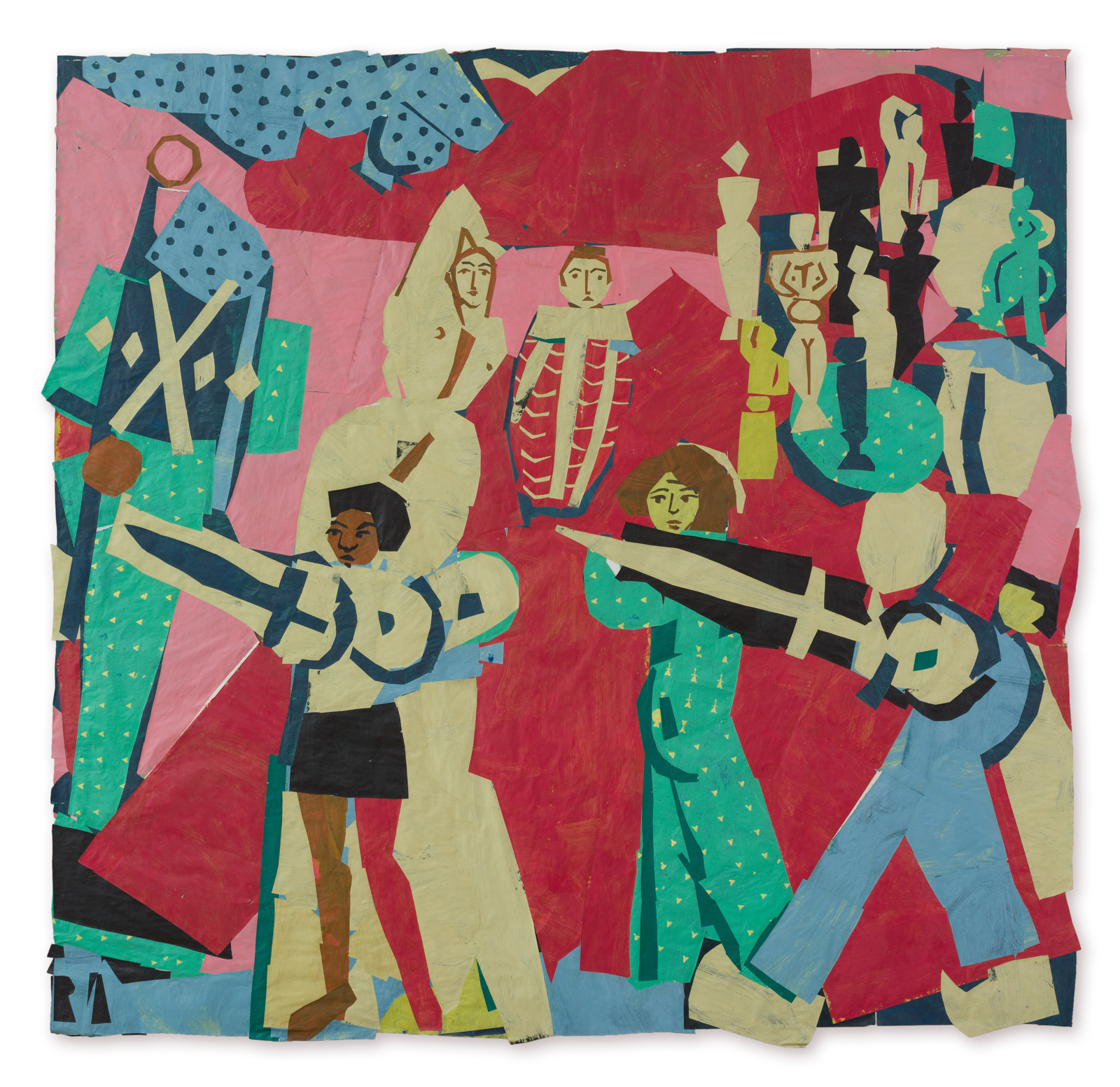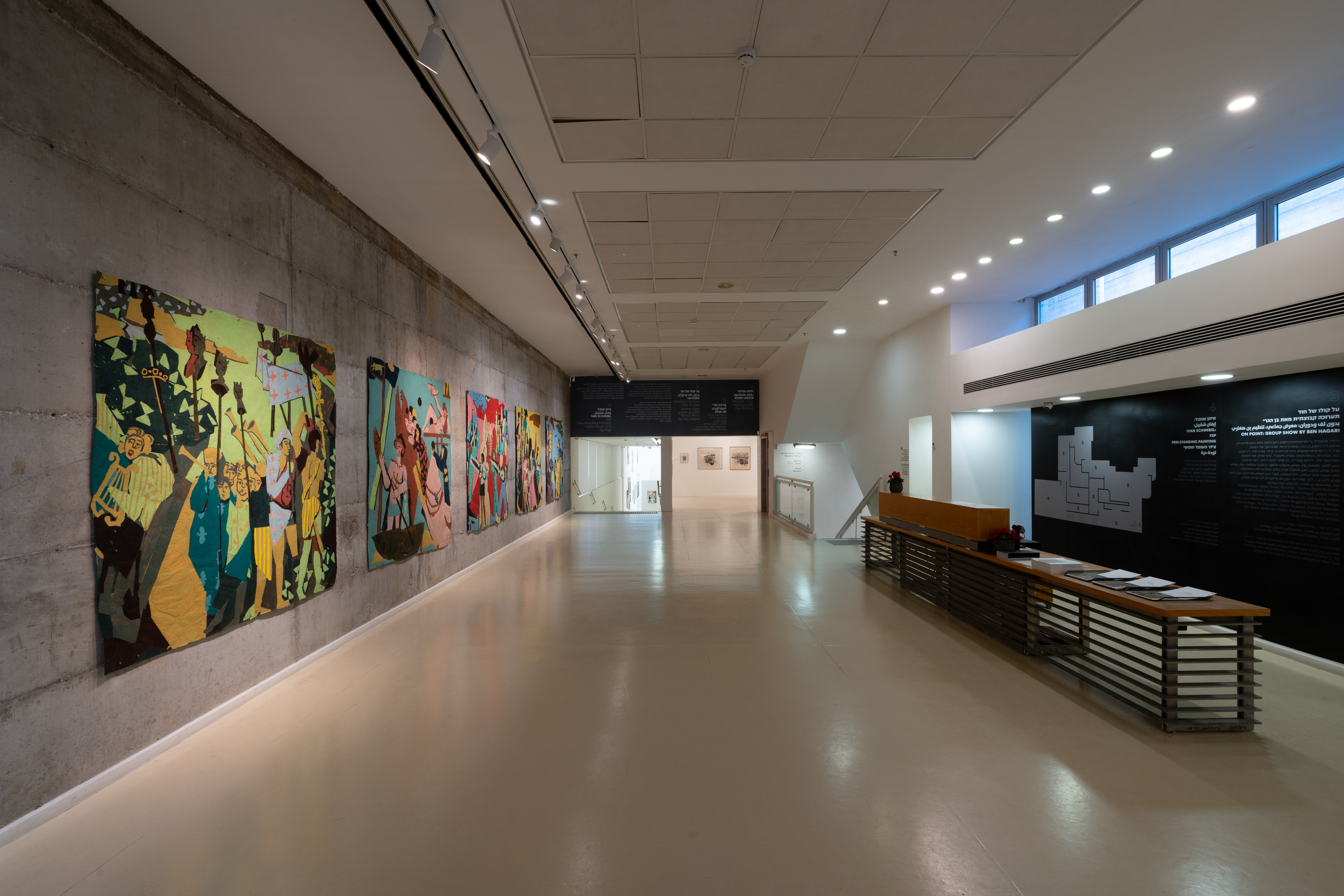







Rotem Amizur: The Flatland
Herzliya Museum of Contemporary Art
Curator: Iddo Markus
The Flatland is a monumental project that began with Rotem Amizur’s chance encounter with a small and faded reproduction of one panel out of nine from The Triumphs of Caesar (1484–92) [fig. 1] – a famous painting by the Renaissance artist Andrea Mantegna (ca. 1431–1506). The artist chose that reproduction instantly, without much consideration, and started responding to the centuries-old painting the same day. She produced countless interpretations of the painting’s structure, with strong and vibrating colors, in a mixed technique of painting and collage.
Amizur recounts that the reproduction, like any inspiring object, spurred her into action. Her project does not seek to explore the painting, nor does it seek to imitate or copy it, but to reveal its underlying themes and construct a different melody from them. She searched for the roots of that painting, and from them sought to produce original interpretations that, on occasion, venture far beyond the initial image. Mantegna’s painting consists of nine panels that depict a long triumphal procession of the spoils of war: animals, sculptures, flags and countless details, figures and incidents that are difficult for the eye to take in. One of these panels, measuring 268x278 cm, is the source of inspiration for Amizur’s project. The war booty serves as her repository of images, and by reassembling the images she also deconstructs the original meaning of the painting that inspired her. In formalistic and repetitive fashion, she highlights the hierarchy in the composition before her – a work process that dictates a visual order of priorities: what is important and what is not, what must remain and what can be changed or shifted.
Like other artists of his time, Mantegna experimented with perspective – for example, by lowering the horizon to heighten the effect of monumentality. His figures, often appearing as though made of stone, highlight his fundamentally sculptural approach. Such is also the case in the reproduction in question: the procession marches right on the lower border of the canvas, enhancing the illusion that it is doing so here, in our own world; a triumphal march on an endless stage. Delving into only one panel of the mural, Amizur creates her own procession by replicating this fragment and constructs an entire sentence from a deficient vocabulary.
In the unique dialogue in which she engages, Amizur articulates a new hybrid language, one between painting and collage. This choice is founded on a variety of artistic traditions – from the later work of Henri Matisse to Richard Diebenkorn. At the same time, she draws inspiration from quilting and textile techniques. With all that, she gives herself free rein to improvise. Her work, like that of many contemporary painters, has an immediate and frenetic quality to it, and she does not hide the process of how it is made: Thousands of tiny holes in the pieces of paper that make up the collages attest to the changes they underwent in the creative process – a kind of map documenting the movement of her hands as they created and changed, in their attempt to cast an anchor. In that process, the papers – cut into shapes of various sizes – are placed on top of each other, attached to the surface with hundreds of pins before being glued to it. This technique allows for dramatic changes in composition, by moving the forms and re-observing the various permutations. The artist forms one shape, and then another – like a Rubik’s Cube that has been miraculously folded up and laid out anew, or an origami sculpture that has ballooned to gigantic proportions. The material – paper – is characterized by lightness, and so, too, is Amizur’s paper creation. At the same time, its sheer size gives it heft, as does its “weighty” subject and the complexity of the composition.
The genre of historical painting – which for centuries was the leading genre in Europe – is transformed in Amizur’s hands into an intense and explosive formalist game, in which painterly elements and values prevail over the subject. The culmination of the project, on view here, is an enormous collection of works composed of elements borrowed from the worlds of painting and collage, two types of media founded on artistic concepts and traditions of different, and sometimes divergent, nature. Painting, in its classic forms, is based on observation and thoughts about light, air, tonality and composition, while collage, which is a much younger medium (about a hundred years old), is founded on modernist disassembly: several worlds piled on one another and colliding with each other, to express a broken and torn world that is chaotic rather than harmonious. But unlike the modernist collage, which is usually made of newspaper clippings, photographs and more, the raw material in Amizur’s works is simple white paper, uniformly painted in flat industrial paints of custom hues made to Amizur’s specifications. Occasionally, the paper is covered in two different layers of paint, creating depth and a sense of warmness or coolness. These simple pieces of papers serve as the basis for diverse complex operations and surprising encounters, with which Amizur forges a new and wonderful world. The palette – of countless painted pieces of papers – is the only factor known at the outset. This limitation is a basic given in the work, requiring creative solutions on the artist’s part and resulting in the creation of colorful relationships that would not exist had she access to the usual gamut of colors and hues.
Ultimately, the ensemble consists of hundreds of pieces, all performing in Amizur’s great production: every form and patch is in constant dialogue. Amizur’s work offers hundreds of perspectives that change at her bidding, together creating a resonating moment in which the simple becomes complex, and the complex – beautiful. The works were inspired by a black-and-white reproduction, yet are striking for their vivid, vigorous colors. This may seem odd, at first, as Amizur has never seen the colorful original, but perhaps that is precisely what allowed her to disengage from it with relative ease and assert the freedom to produce such original and intense color combinations. Her cut-up pieces of papers are like continents floating tectonically on a flat earth, and the result is a spectacular sight, whose simplicity arises from masterful craftsmanship.